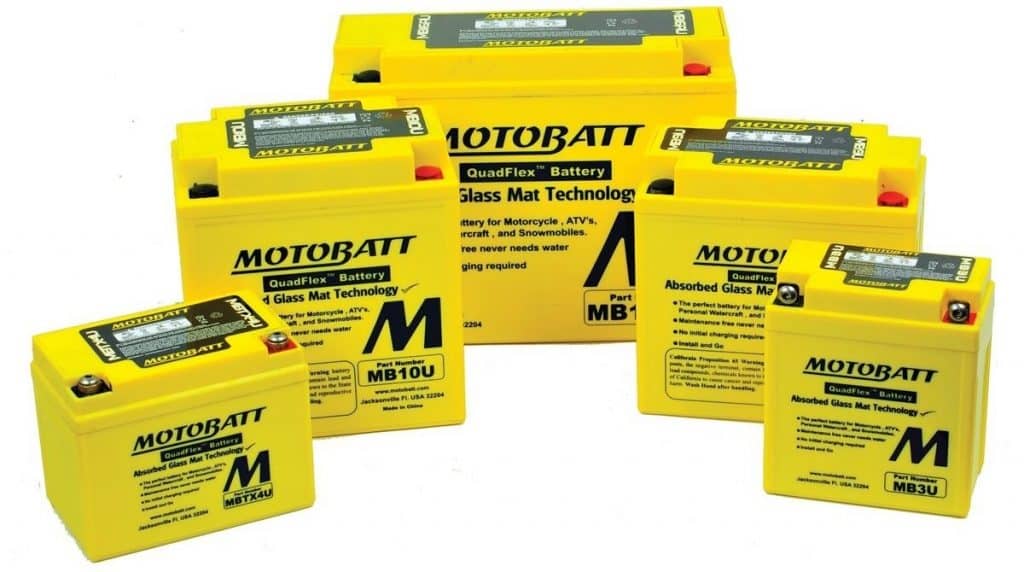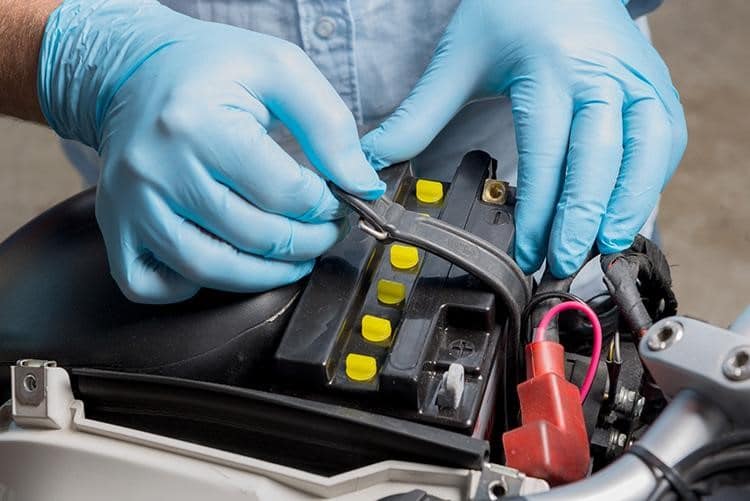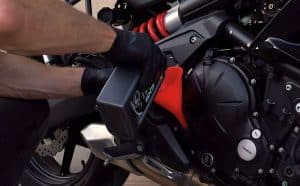A motorcycle battery lasts 3-5 years or even longer with proper care, and the exact longevity of the battery will depend on its type, chemistry, how you use it, how you maintain it, and the climate where your motorcycle spends the most time.
For instance, wet cell lead-acid motorcycle batteries have a lifespan of 2 to 5 years, whereas AGM (Absorbent Glass Matrix) batteries last for 3 to 5 years. For a longer-lasting solution, Lithium Iron Phosphate batteries (LiFePO4) can power a motorcycle for up to 10 years, and gel batteries reign supreme with an impressive durability of up to 20 years.
Best Motorcycle Battery Cleaners
| Battery Cleaner Model | Category | Size | Check & Shop Now |
|---|---|---|---|
| Liqui Moly Electronics Cleaner | Best Advanced | 500ml | RevZilla | CycleGear | Amazon |
| Permatex 80369 Battery Cleaner | Best Heavy-Duty | 311g | Amazon |
| MiracleSpray for Electronics Cleaning | Best Multipurpose | 400ml | Amazon |
| Weiman e-Tronic Wipes | Best Convenient | 30 wipes | Amazon |
| Muc-Off Nano Tech Motorcycle Cleaner | Best High-Performance | 1 liter | RevZilla | MotoSport | Amazon |
The 4 Different Types of Motorcycle Batteries
Criteria Wet Cell Battery AGM Battery LiFePO4 Battery Gel Battery
Lifespan 2-5 years 3-5 years Up to 10 years Up to 20 years
Maintenance Requires regular maintenance Virtually maintenance-free Virtually maintenance-free Virtually maintenance-free
Charging Time Shorter than gel Shorter than lead-acid Shortest than AGM, gel and lead-acid Longer than lead-acid
Self-Discharge Per Month 5% per month 1-3%% per month 0.5-2% per month 1-3% per month
Maximum Depth of Discharge (DOD) 80% 50% 100% 75%
Weight Per 100 ah 32 kg 28.5 kg 12.5 kg 30 kg
Performance in Cold Temperatures Decreases Better than lead-acid Best performance Better than average performance
Environmental Impact Can be harmful if not disposed properly More eco-friendly than lead-acid Most environmentally friendly Leak and spill-proof. Safer than AGM and lead-acid
Vibration/Tipping Resistance Poor Average Very good Good
Price Inexpensive About 30% more expensive than lead-acid 50% more expensive than Gel More expensive than AGM and lead-acid
From motorcycles to cars, batteries are the lifeblood of our vehicles, and knowing how long does a motorcycle battery last, which mainly comes down to the type you choose, can be the difference between a smooth ride and a bumpy road.

Simply put, a motorcycle battery is an energy accumulator which uses chemical reactions to store electric energy. A chemical reaction happens one way while charging, and the reverse regenerates a certain percentage of that energy depending on the efficiency of the battery.
And for me to effectively answer your question on how long does a motorcycle battery last, allow me to explain the different types of motorcycle batteries:
1. Lead-Acid Batteries

A standard nearing the end of its life, lead-acid accumulators have been around for well over 150 years. They’re the most common and least expensive motorcycle batteries with the advantage of high intensity at startup. But they are heavy and quickly show their limit when more power is needed, but there’s less room available for more batteries and where weight is a concern.
Lead-acid batteries suffer self-discharge and drying out, requiring regular maintenance both by charging and sometimes topping up electrolytes. They also don’t last long with vibrations and constant tipping over as is the case in motorcycles, and may, therefore, not be the most economical option despite their attractive pricing.
2. AGM Batteries

Although the AGM and gel terms are often used interchangeably, they’re slightly different. The two technologies have been around for less than 40 years, and here is the distinction between the two.
An AGM battery on its part can be termed as the best of both worlds–a cross between lead acid and gel accumulators. They have twice the power to weight ratio of lead-acid batteries but feature a gel electrolyte and glass fiber separator in between the plates.
This construction saves on the cost (typically 30% more expensive than lead-acid batteries) while offering an excellent compromise between the two technologies.
3. Gel Batteries

Gel batteries, on the other hand, with their gel electrolyte, possess an exceptional ability to resist vibrations and tipping as they undergo a construction process that builds them for extreme durability, resulting in a lifespan of up to two decades–a 30% increase in capacity compared to AGM, flooded lead-acid batteries.
They also require minimal maintenance, making them an ideal option for motorcycle enthusiasts who seek a long-lasting, reliable power source. And while they come with a higher price tag and require longer charging times, these minor trade-offs are negligible compared to the benefits of owning a gel battery.
4. LiFePO4 Batteries

Lithium-ion batteries have been around for only a few decades but have already married with controversy over their tendency to catch fire. For a while, this impeded the development of larger battery packs containing Lithium Ion until the new Lithium Iron Phosphate technology was invented. This new chemistry makes them non-combustible in nature and still at least 10 times more durable than AGM batteries.
LiFePO4s have higher efficiency and can be discharged deeply (up to 100%!) whereas traditional batteries cannot lose more than 50% of their energy without damaging their cells. Also, there are other lithium-ion batteries made of lithium salts such as Lithium Nickel, Manganese Cobalt Oxide (NMC), and Lithium Nickel Cobalt Aluminum Oxide.
Factors That Determine the Lifespan of a Motorcycle Battery and How to Extend It

Because the chemicals discussed above change, battery capacity deteriorates over time and with use regardless of how well the battery is kept. Here is a brief summary of factors that affect the performance and life of a motorcycle battery.
Frequency of Use
The more you use your motorcycle, the longer the battery will last. By use, I mean actually riding the motorcycle for longer than 15 minutes to allow the battery to recharge. Don’t start and idle your motorcycle to charge the battery. It’s counterproductive because starting up draws the most energy out of the battery, and idling does not charge up the battery. Even revving the motorcycle without movement destroys the engine with heat, so don’t do that either.
Alternatively, remove the battery completely from the motorcycle and connect it to a battery tender to keep it charged and ready for the next riding season.
Regular Battery Checks and Maintenance

Routinely check your battery’s health with a multimeter and visual inspection. First, check the battery exterior for damage, voltage, electrolyte levels, and terminal corrosion.
Check Voltage
To check the battery voltage you can install a battery meter on the bike or use an external multimeter to measure the voltage between the two terminals. A conventional lead-acid battery will have 12.6 to 12.8 V when fully charged and 12.4 when three-quarters full.
An AGM battery has an open circuit voltage between 12.8 and 13.0 when fully charged and 12.5V when 75% charged, while a lithium-ion one will carry about 14.4 volts to 14.6 when fully charged.
Refill the Electrolyte
If you are running a non-sealed wet cell battery, you can refill with the proper electrolyte (typically distilled water) to the indicated level. You will know it is because of the maximum and minimum level indicators and caps to open and pour in the electrolyte. Don’t use tap water as it may contain ions, which may break things!
Clean Corrosion On Terminals
If there is significant corrosion, clean it using a specialized cleaner or a homemade solution made by mixing 2-3 tablespoons of baking soda with 30 ml (about an ounce) of water.
Climate
Ambient temperature extremities also affect the performance and longevity of your motorcycle battery. Heat waves cause the battery fluids in flooded lead-acid batteries to evaporate leading to sulfation while extreme cold slows down the chemical reactions reducing the power output of each battery cell.
These batteries also lose about 20% of their capacity at -10°F and about 50% at -22°F. Most manufacturers advise against charging the battery at all when the temperature is below 32°F (0°C).
In contrast, Lithium-ion (LiFePO4 or LFP) batteries are more stable and dependable in cold weather because of their acid-free chemistry. Similarly, AGM batteries have low self-discharge rate compared to ordinary lead-acid accumulators and will provide higher cold cranking amps (CCAs) even under frigid weather.
Just the same, a good practice is to store your bike in a warm place and your batteries separately through winter.
Age
Even with proper use and care, a battery will inevitably become less efficient and eventually fail. This happens as the chemicals in the battery degrade and change into other forms. The process is faster if it’s left unattended. A good Lithium-ion battery will give you upwards of 1,000 charging and discharging cycles, which is twice the lifespan of a lead acid one, which can manage around 500 cycles.
Keep in mind this is under laboratory conditions where charging and discharging is done according to specifications.
5 Signs You Need a New Motorcycle Battery

Here are the tell-tale signs your battery is about to die on you:
- Slow Cranking: The engine turns over sluggish possibly with a clicking sound when starting, this indicates the starter motor is underpowered and a weak battery. It may also fail to start completely after a few attempts.
- Chronic Low Voltage: Having trouble with cold starts? Your battery may not be storing enough charge to start your motorcycle, and you may need a replacement.
- Dimmed Headlights: If your lights don’t appear bright enough even when the engine is not running, then you may have a weak battery. You may also find the lights brighten when you rev the engine, which is when the alternator is pushing voltage into the battery. That is normal, but the fluctuation should not be very noticeable.
- Swollen or Leaking Casing: A swollen or punctured is hazardous as it may explode or leak the corrosive and toxic cell contents. When some of the electrolyte spills out of the casing, it is impossible that the battery will still operate as intended.
- Corroded Terminals: Corrosion at the terminals is normal for most battery types and should be cleaned regularly to restore the battery health. But beyond a certain limit, the terminals are eaten away to the point of no return, and there is no alternative but to replace the battery. Exactly how badly, we’ll let you be the judge of that!
Pro Tip: Choose a battery with the largest AH and highest CCA if you want the best one for your motorcycle. It won’t let you down, I promise!
Final Thoughts on How Long Does a Motorcycle Battery Last
Now that we know all motorcycle batteries inevitably tap out, it’s wise to get a replacement before you find yourself desperately in need of one by the roadside. The flooded lead-acid and AGM batteries offer respectable durability of 2-5 and 3-5 years, respectively, whereas the Lithium-ion and gel batteries stand out with remarkable longevity of up to 10 and 20 years, respectively.
For those who value long-lasting and dependable performance with the added benefit of maintenance-free operation, either of these options would be an excellent choice. Keep on cranking, and ride safe!
I've diligently categorized my motorcycle gear recommendations into all available categories, with the aim of providing you with a comprehensive analysis that showcases the absolute best options for all your needs. These items are the culmination of in-depth research, extensive testing, and personal use throughout my vast experience of 50+ years in the world of motorcycling. Besides being a passionate rider, I've held leadership positions and offered consultancy services to reputable companies in over 25 countries. To See Top Picks and the Best Prices & Places to Buy: Click Here!

Ni/A













